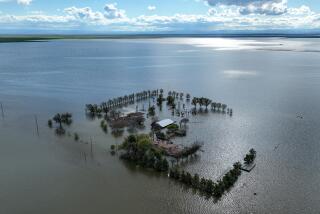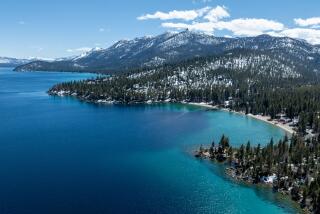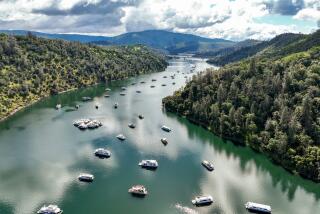Damage in Hundreds of Millions : Threat Eases as Record Levels Drop at Great Lakes
CHICAGO — The Great Lakes are receding after two years of record-high water levels that caused hundreds of millions of dollars of shoreline damage in eight states and two Canadian provinces.
Once-submerged beaches have reappeared in Chicago. Breakwaters are breaking the surface again along the Indiana shore. Piers are back above water in Michigan. And erosion that undermined residential and commercial property throughout the region is less of a threat.
“There has been a significant reduction in the danger,” said Malcolm Todd, an Army Corps of Engineers hydrologic engineer. In some lakes, water has dropped almost three feet from its 1986 high and is down 17 inches or more from where it was a year ago when wind-driven waves caused an estimated $7 million in damage to Chicago’s lakefront roads and parks.
“The immediate crisis atmosphere is certainly diminished,” said Paul Botts, spokesman for the Center for the Great Lakes. “But the . . . last two years galvanized local officials and property owners. In a sense they lost their innocence. . . . There is a permanent awareness of the problem.”
Although fluctuation in the levels of the Great Lakes continues to be the subject of both study and debate among scientists, Todd said the current drop in water levels can be attributed to a sharp drop in precipitation in the region between November, 1986, and June, 1987. “That was the driest it’s been here in 100 years.”
Still over its average depth is Lake Erie, where water levels are about 18 inches above normal. Lake Superior is below its average. Lakes Ontario is at a normal level and Lakes Michigan and Huron are several inches above normal and, Todd said, are expected to remain there through August.
“We’re coming out of the woods from the real extreme highs,” he said. “But when the level is a foot above average, that’s still a lot of water.”
The prolonged high water and the damage caused when high winds whipped up huge waves that battered shorelines from Milwaukee to Buffalo, N.Y., has forced both the federal government and local government to take action.
Late Thursday, the House approved a bill that would provide $100 million over five years to states suffering from flooding or erosion caused by the high water levels. The measure, which was sent to the Senate, would help local governments to repair damage to their facilities and to help homeowners protect private property.
A study in Chicago concluded that it will cost upward of $200 million to protect the city’s shoreline, where some of the most expensive urban residential property in the nation is clustered.
The American and Canadian agency that oversees the Great Lakes, the International Joint Commission, is conducting a study of water levels to determine what, if anything, can be done to relieve “the adverse consequences of fluctuating water levels.”
Holding 20% of the planet’s supply of fresh water, the lakes have 11,240 miles of shoreline varying from sand dunes to rocky bluffs to broad yellow beaches.
Major portions of the Midwestern economy depend on the Great Lakes, where the water supports a recreation industry that generates tens of millions of dollars annually and a shipping industry that keeps the steel mills of the Midwest supplied with iron ore.
More to Read
Sign up for Essential California
The most important California stories and recommendations in your inbox every morning.
You may occasionally receive promotional content from the Los Angeles Times.










